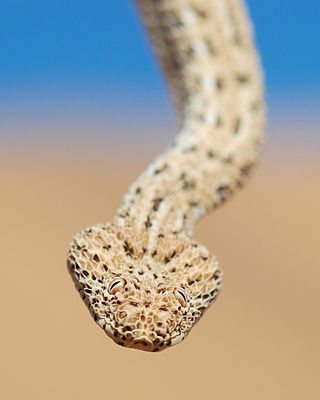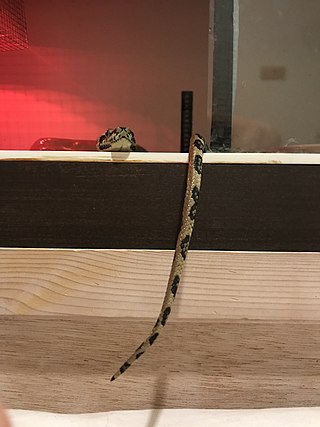
Crotalus cerastes, known as the sidewinder, horned rattlesnake or sidewinder rattlesnake, is a pit viper species belonging to the genus Crotalus, and is found in the desert regions of the Southwestern United States and northwestern Mexico. Like all other pit vipers, it is venomous. Three subspecies are currently recognized.

Sidewinding is a type of locomotion unique to snakes, used to move across loose or slippery substrates. It is most often used by the Saharan horned viper, Cerastes cerastes, the Mojave sidewinder rattlesnake, Crotalus cerastes, and the Namib desert sidewinding adder, Bitis peringueyi, to move across loose desert sands, and also by Homalopsine snakes in Southeast Asia to move across tidal mud flats. Any number of caenophidian snakes can be induced to sidewind on smooth surfaces, though the difficulty in getting them to do so and their proficiency at it vary greatly.

Keeled scales refer to reptile scales that, rather than being smooth, have a ridge down the center that may or may not extend to the tip of the scale, making them rough to the touch. According to Street's (1979) description of European lizards and snakes, in those that have keeled scales the keels are usually stronger in male specimens and are consistently arranged according to the species of reptiles, even though many others do not have them. With European lizards, the dorsal scales are usually well keeled, while those on the flanks are more weakly keeled and those on the belly smooth. Non-European lizards such as Sphaerodactylus macrolepis also display keeled scales.
Horned viper may refer to:

"Asp" is the modern anglicisation of the word "aspis", which in antiquity referred to any one of several venomous snake species found in the Nile region. The specific epithet, aspis, is a Greek word that means "viper". It is believed that aspis referred to what is now known as the Egyptian cobra.

Field's horned viper is a species of snake in the family Viperidae. The species is native to the deserts of the Middle East. Like all other vipers, it is venomous. It was previously considered a subspecies of the Persian horned viper. The main differences between this species and the Persian horned viper are in scalation and venom composition.

Cerastes is a genus of small, venomous vipers found in the deserts and semi-deserts of northern North Africa eastward through Arabia and Iran. Three species are currently recognized by ITIS, and an additional recently described species is recognized by the Reptile Database. Common names for members the genus include horned vipers, North African desert vipers, and cerastes vipers.

Echis is a genus of vipers found in the dry regions of Africa, the Middle East, India, Sri Lanka and Pakistan. They have a characteristic threat display, rubbing sections of their body together to produce a "sizzling" warning sound. The name Echis is the Latin transliteration of the Greek word for "viper" (ἔχις). Like all vipers, they are venomous. Their common name is "saw-scaled vipers" and they include some of the species responsible for causing the most snakebite cases and deaths in the world. Twelve species are currently recognized.

Vipera ammodytes, commonly known as horned viper, long-nosed viper, nose-horned viper, and sand viper, poskok is a species of viper found in southern Europe, mainly northern Italy, the Balkans, and parts of Asia Minor. Like all other vipers, it is venomous. It is reputed to be the most dangerous of the European vipers due to its large size, long fangs and high venom toxicity. The specific name, ammodytes, is derived from the Greek words ammos, meaning "sand", and dutes, meaning "burrower" or "diver", despite its preference for rocky habitats. Five subspecies are currently recognized, including the nominate subspecies described here.

The horned adder is a viper species. It is found in the arid region of southwest Africa, in Angola, Botswana, Namibia; South Africa, and Zimbabwe. It is easily distinguished by the presence of a single, large horn-like scale over each eye. No subspecies are currently recognized. Like all other vipers, it is venomous.

Bitis peringueyi, also known as the Peringuey's adder, Peringuey's desert adder or desert sidewinding adder, is a venomous viper species found in Namibia and southern Angola. No subspecies are currently recognized.

Cerastes gasperettii, also known commonly as the Arabian horned viper and Gasperetti's horned viper, is a species of venomous snake in the subfamily Viperinae of the family Viperidae. The species is native to the Arabian Peninsula and north to Palestine (region), Iraq, and Iran. It is very similar in appearance to C. cerastes, but the geographic ranges of these two species do not overlap. No subspecies of C. gasperettii are recognized.

Cerastes vipera, common names Sahara sand viper and Avicenna viper, is a viper species endemic to the deserts of North Africa and the Sinai Peninsula. No subspecies are currently recognized. Like all other vipers, it is venomous.

Echis pyramidum, known as the Northeast African carpet viper, Egyptian saw-scaled viper, and by other common names, is a species of viper endemic to Northeast Africa and the Arabian Peninsula. Like all other vipers, it is venomous. Three subspecies are currently recognized, including the nominate subspecies described here.

Montivipera xanthina, known as the rock viper, coastal viper, Ottoman viper, and by other common names, is a viper species found in northeastern Greece and Turkey, as well as certain islands in the Aegean Sea. Like all other vipers, it is venomous. No subspecies are currently recognized.

The fiery flying serpent is a creature mentioned in the Book of Isaiah in the Tanakh.

The Persian horned viper, known as the Persian horned viper, false horned viper, and by other common names, is a species of vipers endemic to the Middle East and Asia. Like all other vipers, it is venomous.

Caudal luring is a form of aggressive mimicry characterized by the waving or wriggling of the predator's tail to attract prey. This movement attracts small animals who mistake the tail for a small worm or other small animal. When the animal approaches to prey on the worm-like tail, the predator will strike. This behavior has been recorded in snakes, sharks, and eels.



















